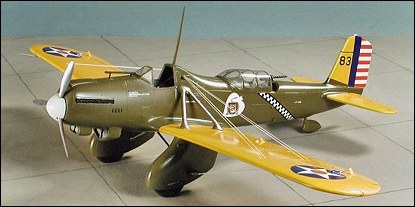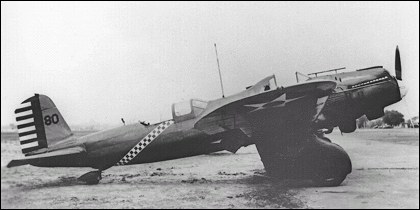 |
Curtiss A-8 Shrike / Model 591931 |  |
| ATTACK AIRCRAFT | Virtual Aircraft Museum / USA / Curtiss |
 |
The quest for speed led to the production of two competing monoplane prototypes to meet a US Army attack bomber requirement, which was formulated in 1929. The Atlantic-Fokker XA-7 remained only a prototype, but the Curtiss XA-8 Shrike (Model 59) which made its maiden flight in June 1931 had a considerable impact on the US Army Air Corps. It was indeed an impressive aircraft for its time, the first Curtiss all-metal low-wing monoplane, with such advanced features as automatic leading-edge slots and trailing-edge flaps. The wing was strut-and wire-braced, and the main landing gear comprised two fully-enclosed trousered units, these fairings housing also two 7.62mm machine-guns. Pilot and observer-gunner were accommodated in widely separated cockpits, the former under a fully enclosed canopy and the latter protected by an extended windscreen. Power was provided by a 447kW Curtiss V-1570C inline engine with a radiator beneath the nose, slightly forward of the wing leading edge. Curtiss won a contract for five service test YA-8 (Model 59A) aircraft on 29 September 1931, and these were followed by eight Y1A-8 machines in the following year. Both YA-8s and Y1A-8s had open pilot's cockpits. All were later redesignated A-8 except for one YA-8 which was reworked as the experimental YA-10 (Model 59B) with a 466kW radial engine and one Y1A-8 which became the Y1A-8A with a 503kW V-1570-57 geared engine and a redesigned wing. The A-8s, powered by Prestone-cooled V-1570-31 engines each of 447kW, created something of a sensation in US aviation circles when they went into service with the 3rd Attack Group at Fort Crockett, Texas in April 1932. At that time all other standard equipment was of biplane configuration and the first US Army low-wing monoplane fighter, the Boeing P-26A Peashooter, did not enter squadron service until eight months later. The US Army had ordered a further 46 Shrikes under the designation A-8B, but maintenance problems with the liquid-cooled engines of the A-8s led to the new aircraft being powered by Wright R-1820-21 radial air-cooled engines of 500kW, resulting in the new designation A-12 (Model 60). These aircraft retained the open pilot's cockpit with faired headrest which had been introduced on the A-8 production batch, and carried the same machine-gun armament and bombload. In an attempt to improve co-operation between pilot and observer a major modification had been introduced, the rear cockpit being moved forward with its glazed covering forming a continuation of the fuselage decking immediately behind the pilot's cockpit. After long service with the US Army's attack groups the Shrikes were relegated to second-line units in 1939, but nine A-12s still remained in service in Hawaii when Pearl Harbor was attacked in December 1941. The Chinese nationalist government bought 20 of an export version of the A-12 in 1936; these saw some action against the Japanese in 1937-8.
|  COMPANY PROFILE | |||||||
 |

|

